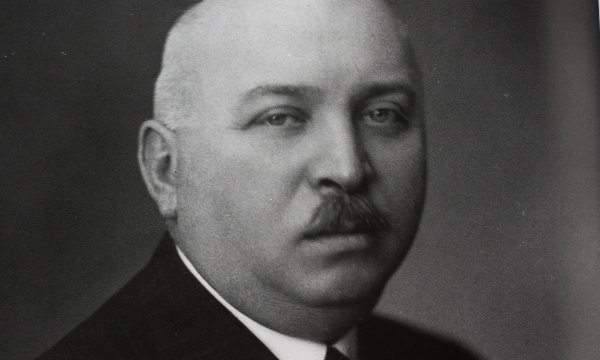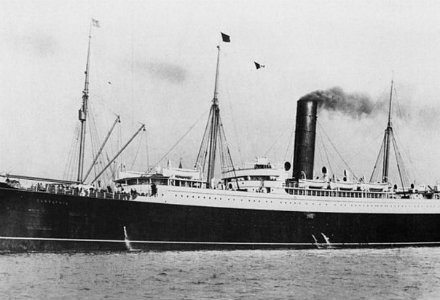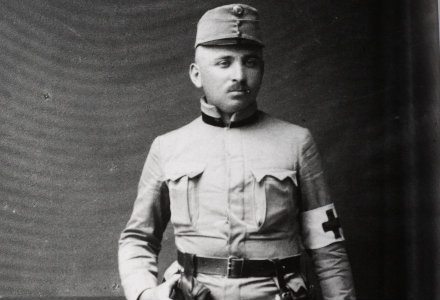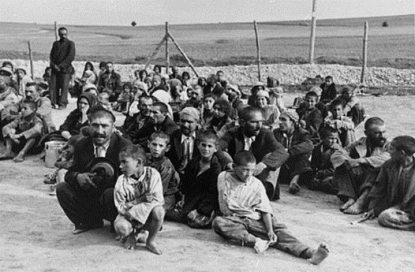Timed to coincide with the hundredthanniversary of the Titanic catastrophe, you have written a book about your grandfather Árpád Lengyel who was a Hungarian ship doctor working on Carpathia, the steamer that hurried to help the sinking luxury boat Titanic. The book?s title In The Shadow of the Titanic also alludes to the fact that even for most Hungarians when they hear about the Titanic, Lengyel?s is not the first name that comes to mind. Why do you think so few people know your grandfather?s story?
Mainly because when it comes to the Titanic, everyone talks first of all about the tragedy. A tragedy like that on April 14-15, 1912 was impossible to imagine during a time of peace. Perhaps it was the first catastrophe that was ?hot off the press? broadcast all over the world thanks to the availability of telegraph transmitters. There have been two world wars since, but the story of the Titanic has survived for some reason. Another factor that has contributed to the story is that everyone thought the Titanic was unsinkable. It was the maiden voyage of this excellently built wonderful boat which transported the elite of the age. They all got on to be part of the Titanic?s first voyage. Then there were those members of the middle class who were happy just to get on the boat and thought of it as a family experience. There were also many emigrants travelling: Italians, Irish and French. It was an international tragedy that affected many nations, including Hungary.
Thanks to the book, Lengyel?s name will hopefully become better known among a wider circle of people.
I hope so. But his name has survived, anyway. The press picked up his name after the catastrophe and it was reported all over the world. According to a speech delivered at his grave, only two Hungarian doctors had international reputations in the early 20th century: Ignác Szemmelweis and Árpád Lengyel. But then Lengyel indeed faded into oblivion. There were the two world wars and after that in the 1950s it was not advisable to talk about acquaintances, friends or family members who had travelled to America, especially not if they had received an award there. It was a taboo subject. Only sometime in the mid 1980s, when Ballard researched the Titanic, did the story surface again but the emphasis was on the catastrophe of the Titanic and not the rescue operations. That?s why I thought my grandfather would indeed deserve to be remembered considering his great efforts and perseverance. National Geographic magazine carried an article specifically about the Carpathia and my grandfather in 2004. That article was written by Tamás Balogh, who is the co-author of the new book. Today, even the Kresz Géza Ambulance Museum presents some photos and documents about him, as well as a 15-minute British-Hungarian documentary. The Hungarian Shipping Secondary School has undertaken patronage of Lengyel?s grave in the Kerepesi cemetery. The Titanic travelling exhibition at the Millenáris in 2007 dedicated an entire corner section to presenting memories connected to my grandfather. I inherited many items from my mother in 2001 and people contacted me at the time of the exhibition and asked me to study the subject more closely. Later, when a temporary exhibition was on display in my grandfather?s birthplace of Pilismarót in 2010, the subject came up again. I started writing the book in 2010 and had to hurry because the anniversary was fast approaching.
What do we know about Lengyel?s life from the time before he worked at the Carpathia. What was his motivation to take the job?
He graduated from medical school as an ear, nose and throat specialist in 1909 and became a practitioner at the Rókus hospital. He read an ad in 1911 showing that Hungarian doctors with English language skills were sought on the Carpathia, a boat that belonged to Cunard Line. Since it was a boat for emigrants, the shipping company considered it necessary that there should be Hungarians in the crew. He really liked the ad, being 26-year-old and single. He thought he would see the world and at the same time get professional practice. He applied and won the post and signed a contract in March 1912. It became his first and only voyage.
Where did he work afterwards?
At many places. He was a GP in Mária Square at the National Worker Aid and Accident Insurer, the predecessor of OTI, and after the organisation became obsolete, he was moved to Kapás Street. Eventually, he became an ambulance doctor and did that for 35 years. Already at medical school, he would sometime work with the ambulance service, which I though was a way to make some cash next to university. He was a medical officer during WWI and was appointed chief medical officer of an ambulance train. For two years, he was a school doctor and health teacher. He also worked as a factory doctor at the Budapest transport company Beszkárt, the predecessor of BKV, and he even had a private practice. I closely studied the background for all these activities and placed strong emphasis on this in the book.
He never received an award at home. What accounts have survived by Lengyel in connection with the tragedy?
A total of five accounts and I included them in full length in the book. The first one he wrote to his brother right on the day when they arrived in New York. Then a month later he gave a lecture at the Budapest Medical Casino. A year later, in 1913, he wrote a memoir which was published in the Ambulance Magazine. On the anniversaries in 1932 and in 1937, he talked about his experiences on the radio. It is really interesting because he would keep writing and talking about the same subject but each time, he had a different approach, shifting emphasis with the passing of time. His first report was characterised by shock but later in the casino, when he addressed other members of the profession, he emphasised the medical aspects of the tragedy. Later on, the tragic nature of the event highlighted, then perseverance, the quick response of the Carpathia captain and the name of the explorer Marconi came up more frequently.
What new information have you found about your grandfather?s personality and the rescue operations as a result of your research?
I came across an article in Ambulance Magazine by Ernő Kálmán, who was another Hungarian doctor working on the Carpathia. This confirmed my grandfather?s report about Carpathia being an extremely well-equipped boat, with plenty of bandages, drugs and foodstuff and that the crew would regularly ? weekly - hold rescue training. The Titanic did not have such drills because it was her maiden voyage and there had been simply no time yet for tests. As for my grandfather, he also had a personal tragedy in his life. In February 1927, he lost his son of seven as a result of diphtheria. The son of a throat specialist dying of diphtheria?what?s more, compulsory vaccination against it was introduced in 1936. Another new discovery about my grandfather was how many areas he worked in and how many places he lived.
How did he handle the sudden popularity that resulted from his rescue activities? Did the medals he received after 1912 change him at all?
Not at all. Because he received them from abroad, he was never decorated in Hungary. The Archduke Joseph August and Princess Auguste once invited him for a chat and on another occasion for dinner. And quite many newspaper articles were written about him. He was only awarded by the ambulance services: the iron medal of merit, the highest recognition in the profession. But he never received an award at home in recognition of his work on the Titanic. The rescued passengers of the boat gave a gold medal to the Carpathia?s officers, including my grandfather, and the Liverpool Shipwreck and Humane Society granted a Silver Medal and Illuminated Certificate of Thanks to him. But he never talked about these memories among friends and family because the memories were so shocking to him. He buried deep the death of his son and the tragedy of the Titanic.
Was he never able to get over it?
No. He saw human tragedies that are very difficult to comprehend with a clear head. What really helped him was that he managed to meet every rescued passenger because after they opened the side doors to lift the rescued from the life boats, he was the first point of contact. Of the three doctors on board, he was the only one with ambulance experience and the captain therefore asked him to stand by the door where the rescued people were received. My grandfather, being an ambulance doctor, could immediately tell who needed what type of help. He wrote of many fractured bones and almost everybody being in a state of shock, which he found the most disturbing. They rescued a total of 705 people, so you can imagine that it was a lot of work. There were little babies onboard, not even able to speak yet. They were just handed over to anyone who had the chance to survive. There were a total of eight couples on their honeymoon and only two couples and six of the young women survived. There were no families at all who would have come away from the accident without a loss. It must have been terrible to come to grips with that, even for a doctor. And indeed he never managed to get over it.
Source: Múlt-kor




